YAMAHA V1 2015 Workshop Manual
Manufacturer: YAMAHA, Model Year: 2015, Model line: V1, Model: YAMAHA V1 2015Pages: 94, PDF Size: 3.01 MB
Page 51 of 94
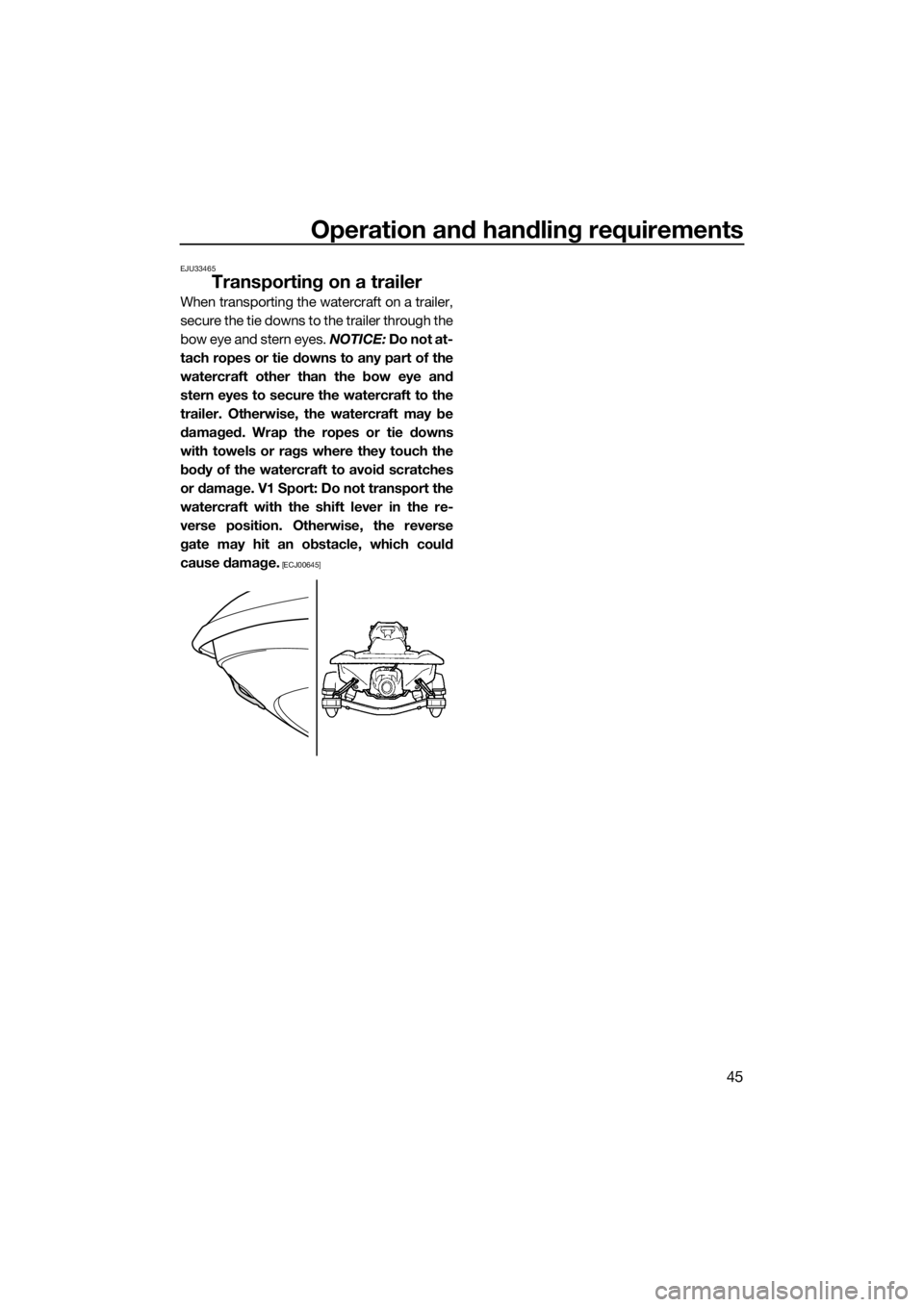
Operation and handling requirements
45
EJU33465
Transporting on a trailer
When transporting the watercraft on a trailer,
secure the tie downs to the trailer through the
bow eye and stern eyes. NOTICE: Do not at-
tach ropes or tie downs to any part of the
watercraft other than the bow eye and
stern eyes to secure the watercraft to the
trailer. Otherwise, the watercraft may be
damaged. Wrap the ropes or tie downs
with towels or rags where they touch the
body of the watercraft to avoid scratches
or damage. V1 Sport: Do not transport the
watercraft with the shift lever in the re-
verse position. Otherwise, the reverse
gate may hit an obstacle, which could
cause damage.
[ECJ00645]
UF2P72E0.book Page 45 Tuesday, August 26, 2014 10:08 AM
Page 52 of 94

First-time operation
46
EJU32786
Engine break-in
NOTICE
ECJ00432
Failure to perform the engine break-in
could result in reduced engine life or even
severe engine damage.
The engine break-in is essential to allow the
various components of the engine to wear
and polish themselves to the correct operat-
ing clearances. This ensures proper perfor-
mance and promotes longer component life.
To perform the engine break-in:
(1) Check the engine oil level. (See page 42
for information on checking the engine
oil level.)
(2) Launch the watercraft and start the en-
gine. (See page 57 for information on
starting the engine.)
(3) For the first 5 minutes, operate with the
engine at idling speed.
(4) For the next 30 minutes, operate with the
engine speed below 5000 r/min.
(5) For the next 1 hour, operate with the en-
gine speed below 6500 r/min.
After the engine break-in is complete, the wa-
tercraft can be operated normally.
UF2P72E0.book Page 46 Tuesday, August 26, 2014 10:08 AM
Page 53 of 94

Pre-operation checks
47
EJU31982
WARNING
EWJ00412
Failure to inspect or maintain the watercraft properly increases the possibility of an ac-
cident or damage to the watercraft. Do not operate the watercraft if you find any prob-
lem. If a problem cannot be corrected by the procedures provided in this manual, have
the watercraft inspected by a Yamaha dealer.
EJU41234Pre-operation checklist
Before using this watercraft, be sure to perform the checks in the following checklist.
ITEM ROUTINE PAGE
PRE-LAUNCH CHECKS
Engine compartmentVentilate the engine compartment.
Check inside the engine compartment for damage.49
Fuel systemCheck the fuel system for leakage.
Check the fuel level in the fuel tank.49
Water separatorCheck the water separator for water. 49
Engine unitCheck the exterior of the engine unit for damage. 49
Engine oil levelCheck the engine oil level. 49
Bilge waterCheck the engine compartment for bilge water. 50
BatteryCheck the battery connections and electrolyte level. 50
Steering systemCheck the steering system for proper operation. 50
Reverse system (V1 Sport)Check the reverse system for proper operation. 51
Throttle leverCheck the throttle lever for proper operation.
Check the throttle lever free play.52
Engine shut-off cord (lan-
yard)Check the engine shut-off cord (lanyard) for dam-
age.52
SwitchesCheck the start switch, engine stop switch, and en-
gine shut-off switch for proper operation.53
Storage compartmentsCheck the storage compartments for damage and
water.53
Fire extinguisher holder,
cover, and bandCheck the fire extinguisher holder, cover, and band
for damage.53
Fire extinguisherCheck the condition of the fire extinguisher. 53
Safety equipmentCheck that safety equipment meeting the applica-
ble regulations is on board.54
Hull and deckCheck the hull and deck for damage. 54
Jet intakeCheck the jet intake for damage and clogging. 54
Stern drain plugsCheck the stern drain plugs for damage and foreign
material and check that they are securely installed.54
HoodCheck that the hood is securely closed. 54
SeatCheck that the seat is securely installed. 34
UF2P72E0.book Page 47 Tuesday, August 26, 2014 10:08 AM
Page 54 of 94

Pre-operation checks
48
TIP:
To ensure safety and reliability, pre-operation checks should be made each time the water-
craft is used.
POST-LAUNCH CHECKS
Cooling water pilot outletCheck that water is discharged from the cooling
water pilot outlet while the engine is running.55
Multifunction information
centerCheck the multifunction information center for prop-
er operation.55
Engine idling speedCheck the engine idling speed. 55 ITEM ROUTINE PAGE
UF2P72E0.book Page 48 Tuesday, August 26, 2014 10:08 AM
Page 55 of 94
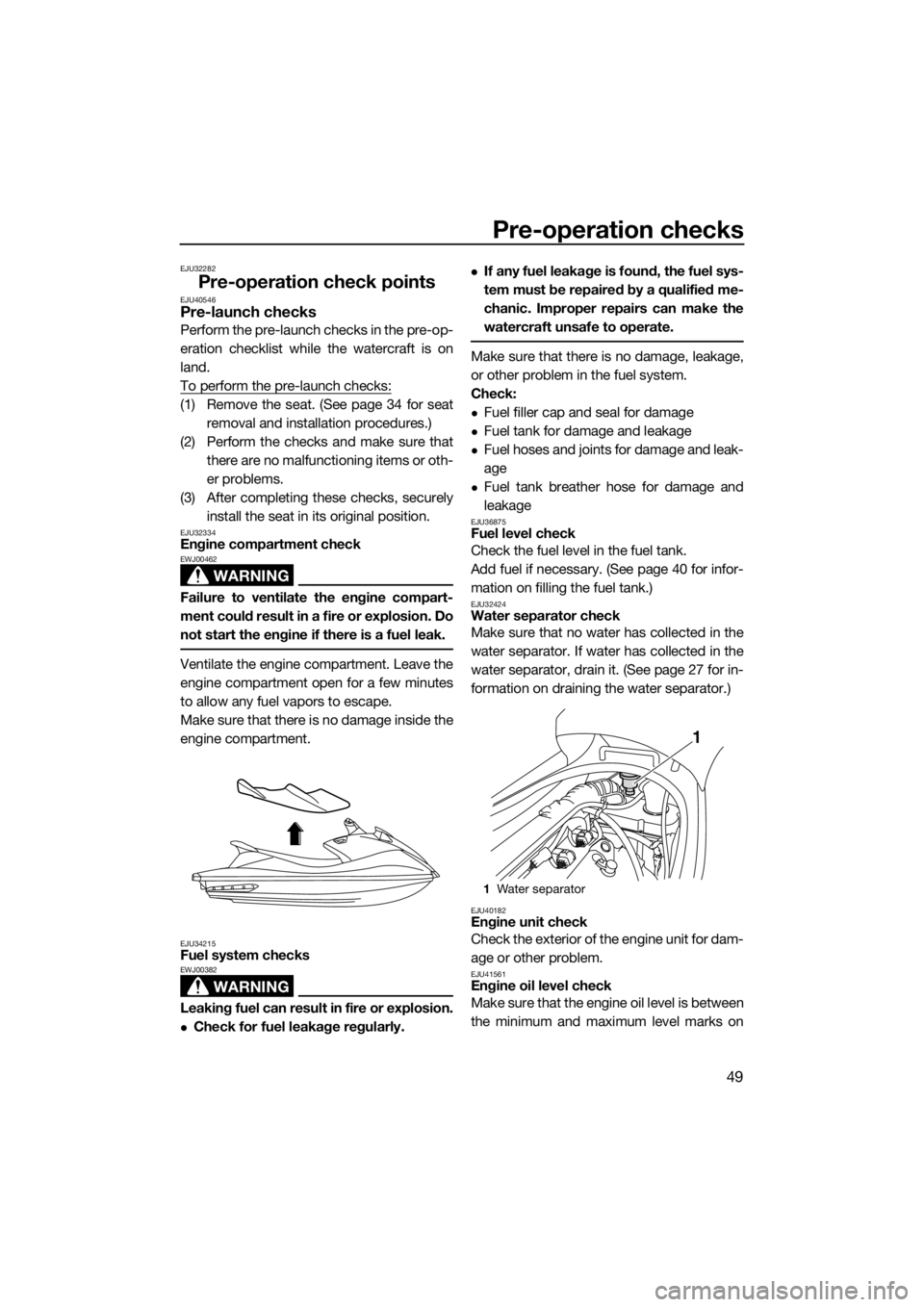
Pre-operation checks
49
EJU32282
Pre-operation check pointsEJU40546Pre-launch checks
Perform the pre-launch checks in the pre-op-
eration checklist while the watercraft is on
land.
To perform the pre-launch checks:
(1) Remove the seat. (See page 34 for seat
removal and installation procedures.)
(2) Perform the checks and make sure that
there are no malfunctioning items or oth-
er problems.
(3) After completing these checks, securely
install the seat in its original position.
EJU32334Engine compartment check
WARNING
EWJ00462
Failure to ventilate the engine compart-
ment could result in a fire or explosion. Do
not start the engine if there is a fuel leak.
Ventilate the engine compartment. Leave the
engine compartment open for a few minutes
to allow any fuel vapors to escape.
Make sure that there is no damage inside the
engine compartment.
EJU34215Fuel system checks
WARNING
EWJ00382
Leaking fuel can result in fire or explosion.
Check for fuel leakage regularly.
If any fuel leakage is found, the fuel sys-
tem must be repaired by a qualified me-
chanic. Improper repairs can make the
watercraft unsafe to operate.
Make sure that there is no damage, leakage,
or other problem in the fuel system.
Check:
Fuel filler cap and seal for damage
Fuel tank for damage and leakage
Fuel hoses and joints for damage and leak-
age
Fuel tank breather hose for damage and
leakage
EJU36875Fuel level check
Check the fuel level in the fuel tank.
Add fuel if necessary. (See page 40 for infor-
mation on filling the fuel tank.)
EJU32424Water separator check
Make sure that no water has collected in the
water separator. If water has collected in the
water separator, drain it. (See page 27 for in-
formation on draining the water separator.)
EJU40182Engine unit check
Check the exterior of the engine unit for dam-
age or other problem.
EJU41561Engine oil level check
Make sure that the engine oil level is between
the minimum and maximum level marks on
1Water separator
1
UF2P72E0.book Page 49 Tuesday, August 26, 2014 10:08 AM
Page 56 of 94
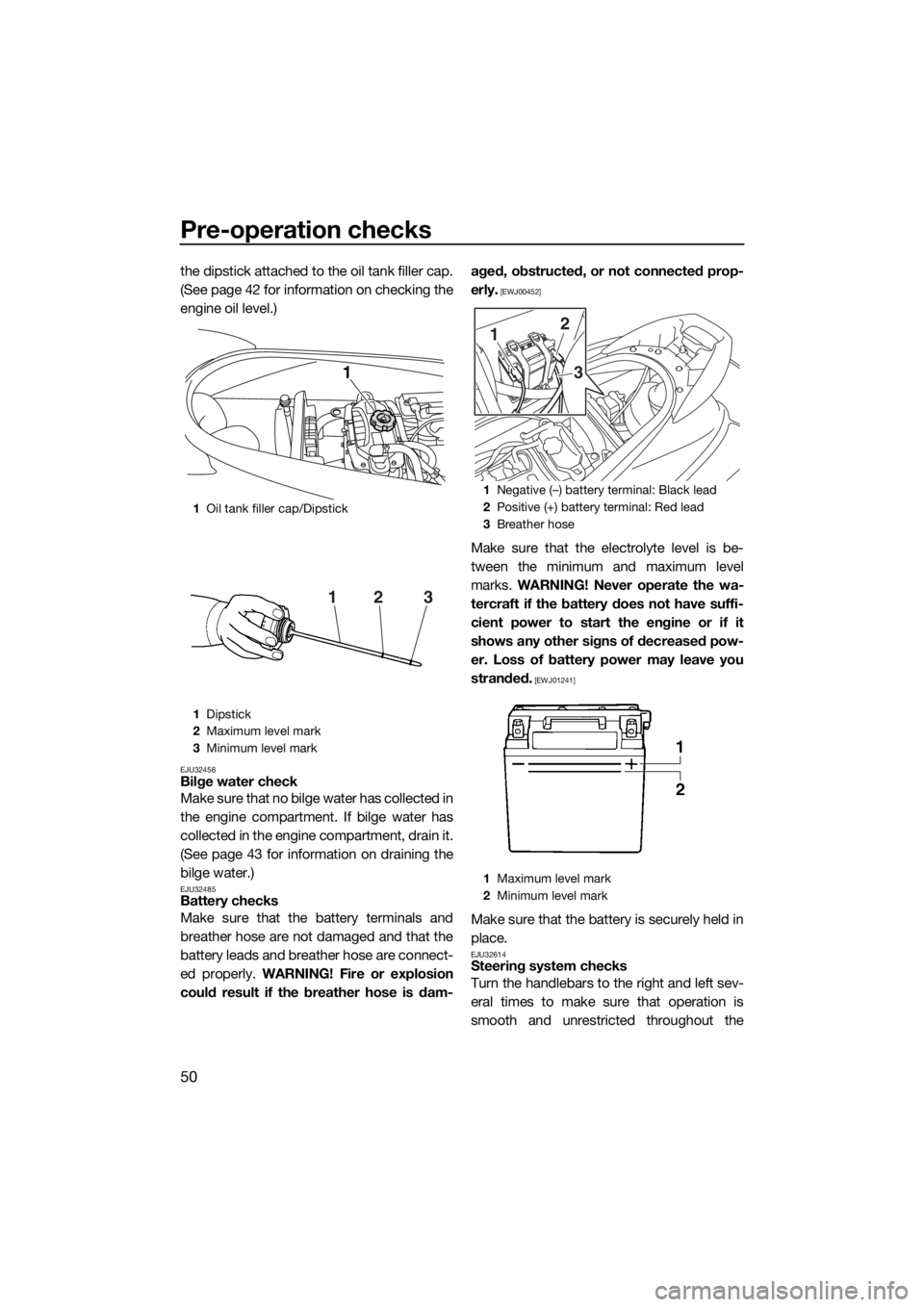
Pre-operation checks
50
the dipstick attached to the oil tank filler cap.
(See page 42 for information on checking the
engine oil level.)
EJU32456Bilge water check
Make sure that no bilge water has collected in
the engine compartment. If bilge water has
collected in the engine compartment, drain it.
(See page 43 for information on draining the
bilge water.)
EJU32485Battery checks
Make sure that the battery terminals and
breather hose are not damaged and that the
battery leads and breather hose are connect-
ed properly. WARNING! Fire or explosion
could result if the breather hose is dam-aged, obstructed, or not connected prop-
erly.
[EWJ00452]
Make sure that the electrolyte level is be-
tween the minimum and maximum level
marks. WARNING! Never operate the wa-
tercraft if the battery does not have suffi-
cient power to start the engine or if it
shows any other signs of decreased pow-
er. Loss of battery power may leave you
stranded.
[EWJ01241]
Make sure that the battery is securely held in
place.
EJU32614Steering system checks
Turn the handlebars to the right and left sev-
eral times to make sure that operation is
smooth and unrestricted throughout the
1Oil tank filler cap/Dipstick
1Dipstick
2Maximum level mark
3Minimum level mark
1
213
1Negative (–) battery terminal: Black lead
2Positive (+) battery terminal: Red lead
3Breather hose
1Maximum level mark
2Minimum level mark
12
3
UF2P72E0.book Page 50 Tuesday, August 26, 2014 10:08 AM
Page 57 of 94
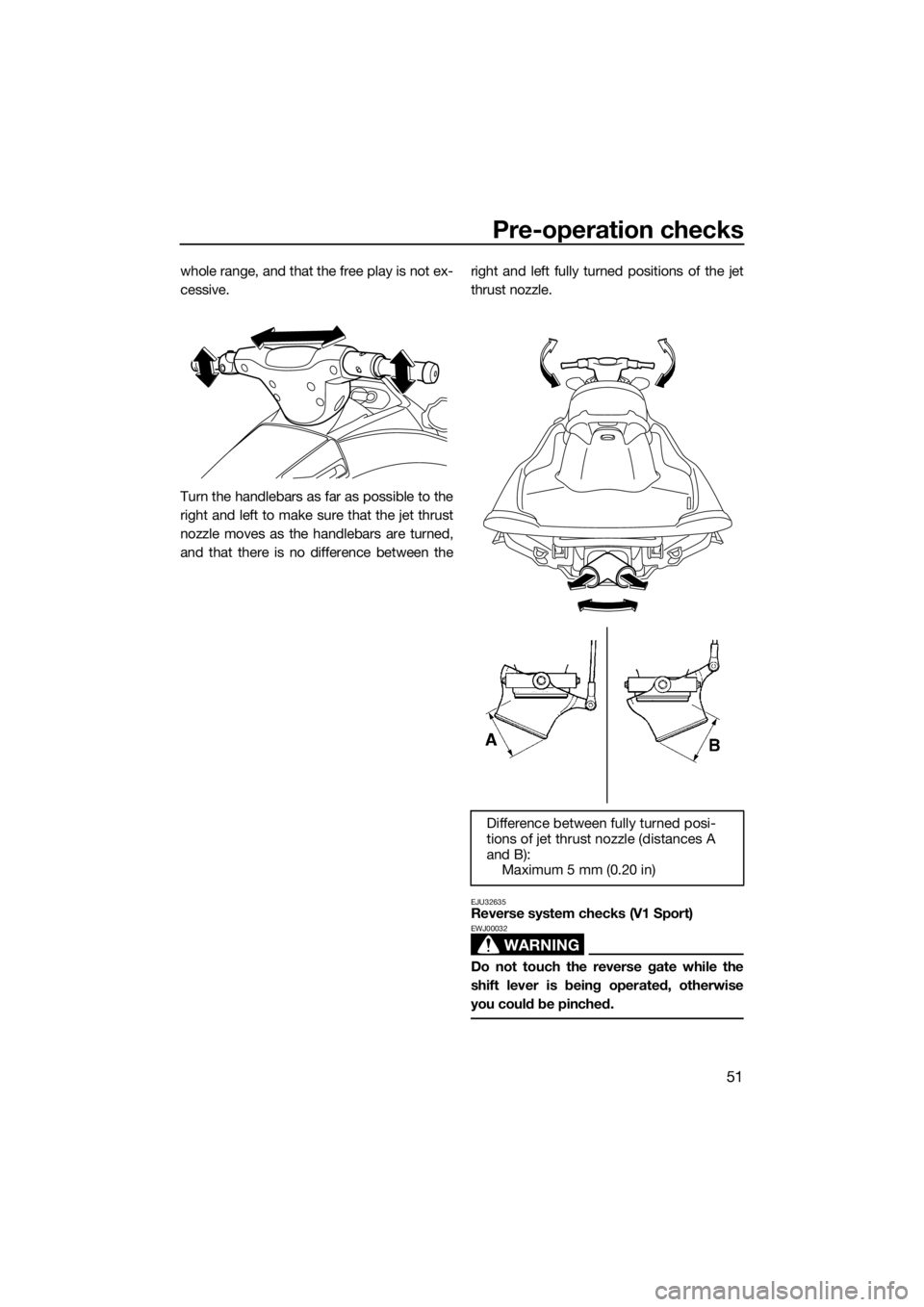
Pre-operation checks
51
whole range, and that the free play is not ex-
cessive.
Turn the handlebars as far as possible to the
right and left to make sure that the jet thrust
nozzle moves as the handlebars are turned,
and that there is no difference between theright and left fully turned positions of the jet
thrust nozzle.
EJU32635Reverse system checks (V1 Sport)
WARNING
EWJ00032
Do not touch the reverse gate while the
shift lever is being operated, otherwise
you could be pinched.
Difference between fully turned posi-
tions of jet thrust nozzle (distances A
and B):
Maximum 5 mm (0.20 in)
UF2P72E0.book Page 51 Tuesday, August 26, 2014 10:08 AM
Page 58 of 94
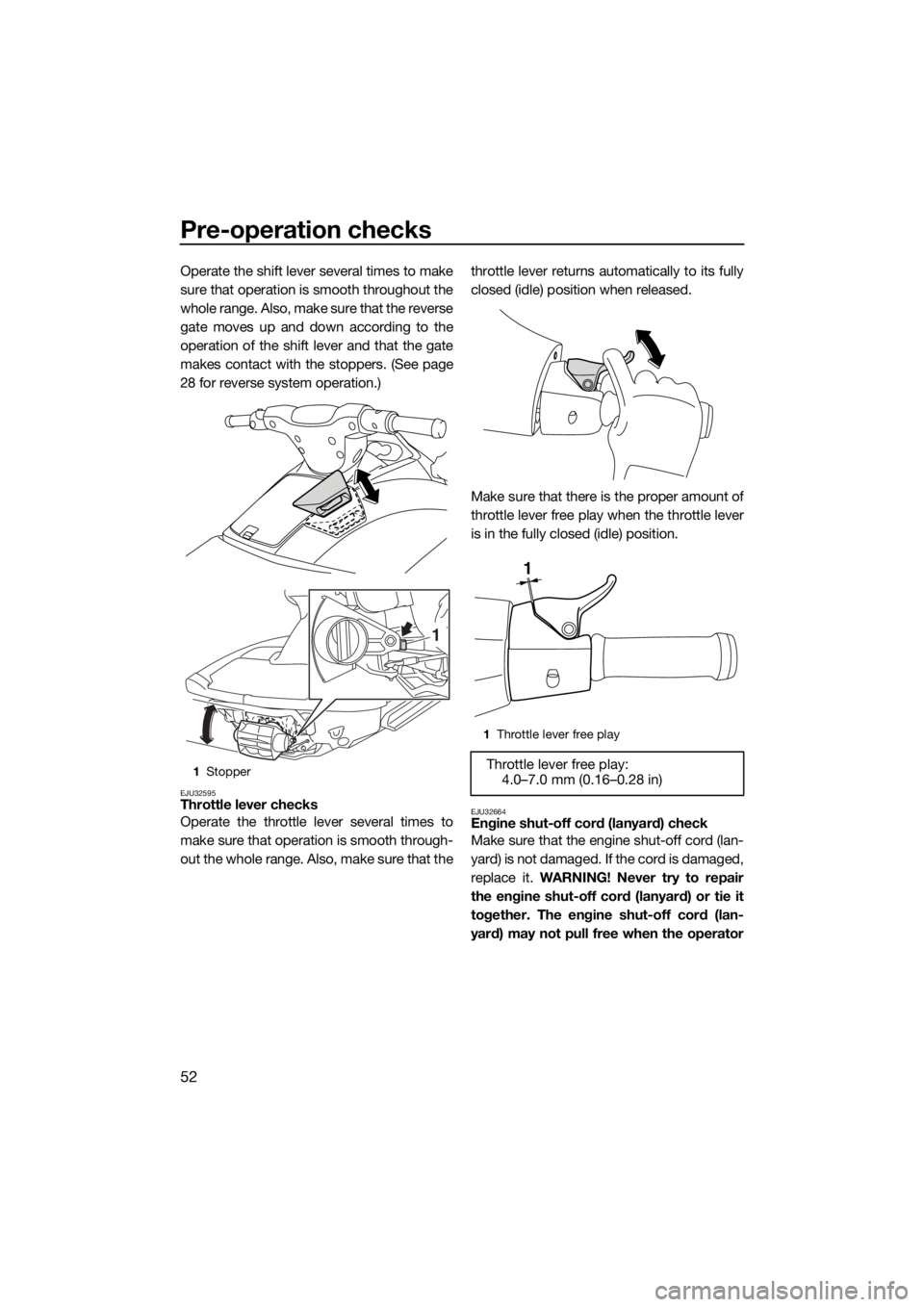
Pre-operation checks
52
Operate the shift lever several times to make
sure that operation is smooth throughout the
whole range. Also, make sure that the reverse
gate moves up and down according to the
operation of the shift lever and that the gate
makes contact with the stoppers. (See page
28 for reverse system operation.)
EJU32595Throttle lever checks
Operate the throttle lever several times to
make sure that operation is smooth through-
out the whole range. Also, make sure that thethrottle lever returns automatically to its fully
closed (idle) position when released.
Make sure that there is the proper amount of
throttle lever free play when the throttle lever
is in the fully closed (idle) position.EJU32664Engine shut-off cord (lanyard) check
Make sure that the engine shut-off cord (lan-
yard) is not damaged. If the cord is damaged,
replace it. WARNING! Never try to repair
the engine shut-off cord (lanyard) or tie it
together. The engine shut-off cord (lan-
yard) may not pull free when the operator
1Stopper
1
1Throttle lever free play
Throttle lever free play:
4.0–7.0 mm (0.16–0.28 in)
1
UF2P72E0.book Page 52 Tuesday, August 26, 2014 10:08 AM
Page 59 of 94
![YAMAHA V1 2015 Workshop Manual Pre-operation checks
53
falls off, allowing the watercraft to contin-
ue to run and cause an accident.
[EWJ01221]
EJU40692
Switch checks
NOTICE
ECJ01311
Do not run the engine over 4000 r/min on
land. YAMAHA V1 2015 Workshop Manual Pre-operation checks
53
falls off, allowing the watercraft to contin-
ue to run and cause an accident.
[EWJ01221]
EJU40692
Switch checks
NOTICE
ECJ01311
Do not run the engine over 4000 r/min on
land.](/img/51/51943/w960_51943-58.png)
Pre-operation checks
53
falls off, allowing the watercraft to contin-
ue to run and cause an accident.
[EWJ01221]
EJU40692
Switch checks
NOTICE
ECJ01311
Do not run the engine over 4000 r/min on
land. Also, do not run the engine for more
than 15 seconds without supplying water,
otherwise the engine could overheat.
Check the start switch, the engine stop
switch, and the engine shut-off switch for
proper operation. (See pages 25 to 25 for in-
formation on operating each switch.)
To check the operation of the switches:
(1) Push the start switch to make sure that
the engine starts.(2) As soon as the engine starts running,
push the engine stop switch to make
sure that the engine stops immediately.
(3) Restart the engine, and then pull the en-
gine shut-off cord (lanyard) to remove
the clip from the engine shut-off switch
to make sure that the engine stops im-
mediately.
EJU40102Storage compartment checks
Make sure that the storage compartments
are not damaged and that water has not col-
lected in the compartments. (See page 36 for
information on the storage compartments.)
EJU41082Fire extinguisher holder, cover, and band
checks
Make sure that the fire extinguisher holder,
cover, and band are not damaged and that
the cover is securely held in place using the
band. (See page 38 for information on the fire
extinguisher holder, cover, and band.)
EJU32544Fire extinguisher check
Check that there is a full fire extinguisher on
board.
To check the fire extinguisher, see the in-
structions supplied by the fire extinguisher
manufacturer. Always keep the fire extin-
guisher secured in the holder with its cover in
place.
Always carry a fire extinguisher on board. A
fire extinguisher is not standard equipment
1Engine shut-off switch
2Clip
3Start switch
4Engine stop switch
5Engine shut-off cord (lanyard)
123
4
5
UF2P72E0.book Page 53 Tuesday, August 26, 2014 10:08 AM
Page 60 of 94
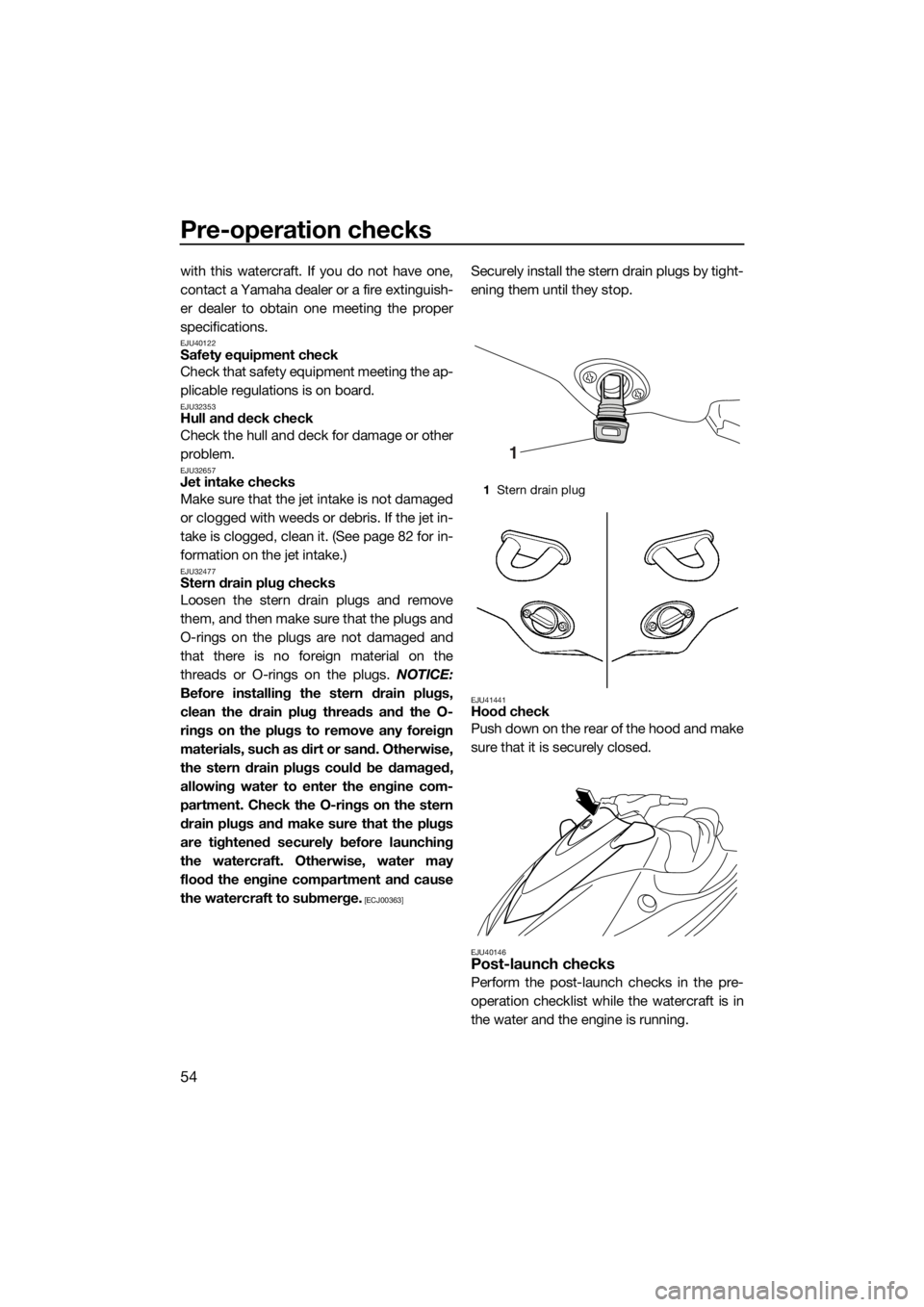
Pre-operation checks
54
with this watercraft. If you do not have one,
contact a Yamaha dealer or a fire extinguish-
er dealer to obtain one meeting the proper
specifications.
EJU40122Safety equipment check
Check that safety equipment meeting the ap-
plicable regulations is on board.
EJU32353Hull and deck check
Check the hull and deck for damage or other
problem.
EJU32657Jet intake checks
Make sure that the jet intake is not damaged
or clogged with weeds or debris. If the jet in-
take is clogged, clean it. (See page 82 for in-
formation on the jet intake.)
EJU32477Stern drain plug checks
Loosen the stern drain plugs and remove
them, and then make sure that the plugs and
O-rings on the plugs are not damaged and
that there is no foreign material on the
threads or O-rings on the plugs. NOTICE:
Before installing the stern drain plugs,
clean the drain plug threads and the O-
rings on the plugs to remove any foreign
materials, such as dirt or sand. Otherwise,
the stern drain plugs could be damaged,
allowing water to enter the engine com-
partment. Check the O-rings on the stern
drain plugs and make sure that the plugs
are tightened securely before launching
the watercraft. Otherwise, water may
flood the engine compartment and cause
the watercraft to submerge.
[ECJ00363]
Securely install the stern drain plugs by tight-
ening them until they stop.
EJU41441Hood check
Push down on the rear of the hood and make
sure that it is securely closed.
EJU40146Post-launch checks
Perform the post-launch checks in the pre-
operation checklist while the watercraft is in
the water and the engine is running.
1Stern drain plug
1
UF2P72E0.book Page 54 Tuesday, August 26, 2014 10:08 AM